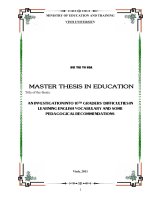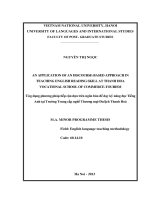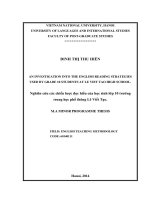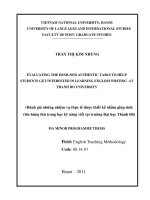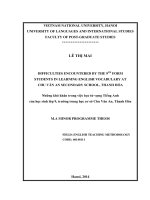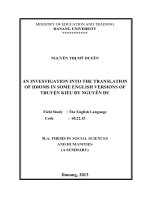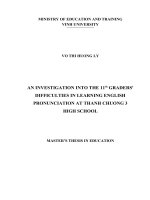An investigation into the 11th graders'' difficulties in learning English pronuciation at Thanh Chuong 3 high school
Bạn đang xem bản rút gọn của tài liệu. Xem và tải ngay bản đầy đủ của tài liệu tại đây (386.96 KB, 86 trang )
MINISTRY OF EDUCATION AND TRAINING
VINH UNIVERSITY
VO THI HUONG LY
AN INVESTIGATION INTO THE 11th GRADERS'
DIFFICULTIES IN LEARNING ENGLISH
PRONUNCIATION AT THANH CHUONG 3
HIGH SCHOOL
MASTER’S THESIS IN EDUCATION
NGHE AN - 2014
MINISTRY OF EDUCATION AND TRAINING
VINH UNIVERSITY
VO THI HUONG LY
AN INVESTIGATION INTO THE 11th GRADERS'
DIFFICULTIES IN LEARNING ENGLISH
PRONUNCIATION AT THANH CHUONG 3
HIGH SCHOOL
Field: Theory and Methodology of English Language Teaching
Code: 60.14.01.11
MASTER’S THESIS IN EDUCATION
Supervisor: NGUYEN GIA VIET Ph.D
NGHE AN - 2014
STATEMENT OF AUTHORSHIP
I hereby acknowledge that this study is mine. The data and findings
discussed in the thesis are true, used with permission, and have not been
published elsewhere.
Author
Vo Thi Huong Ly
i
ACKNOWLEDGEMENTS
I would like to take this opportunity to give my thank to many people
who directly and indirectly help me in accomplishing this research.
First of all, I would like to thank Dr. Nguyen Gia Viet for his kind help
and valuable advice that he provided me throughout my thesis. Without his
help, my thesis may not be completed.
Secondly, I would like to thank all of the teachers from Thanh Chuong
3 high school and all accounting students at Thanh Chuong 3 high school for
their enthusiastic participation and helpful contribution to my research.
I also would like to give my thank to my beloved family and friends
who support me, encourage and help me all the time I do my research.
Vo Thi Huong Ly
ABSTRACT
ii
This master thesis deals with the importance of teaching pronunciation
of the English language at high schools. As the global character of English
language is strengthened every day, the only knowledge of English grammar
and vocabulary is not sufficient as the importance of being able to lead an
intelligible and effective communication plays a great role as well. Therefore,
this master thesis aims at finding out some of the ways which can make an
improvement in terms of teaching pronunciation in English lessons.
iii
TABLE OF CONTENTS
Pages
STATEMENT OF AUTHORSHIP..........................................................................................i
ACKNOWLEDGEMENTS...................................................................................................ii
TABLE OF CONTENTS......................................................................................................iv
LIST OF TABLES.................................................................................................................vi
CHAPTER 1
INTRODUCTION..................................................................................................................1
1.1. Rationale ....................................................................................................................1
1.2. Purpose of the Study...................................................................................................2
1.3. Scope of the Study......................................................................................................3
1.4. The research questions................................................................................................3
1.5. Research methodology................................................................................................3
1.6. Setting and background..............................................................................................4
1.7. Outline of the Study....................................................................................................5
CHAPTER 2
THEORICAL BACKGROUND............................................................................................7
2.1. Role of pronunciation in communicative competence and in foreign language
learning..............................................................................................................................7
2.2. Approaches to pronunciation teaching –pronunciation teaching Methodologies ......8
2.3. Factors affecting pronunciation learning .................................................................10
2.3.1. The native language ...........................................................................................10
2.3.2. The age ..............................................................................................................11
2.3.3. Phonetic ability ..................................................................................................12
2.3.4. Attitudes and identity .........................................................................................12
2.3.5. Motivation and concern for good pronunciation ...............................................12
2.4. Differences in the sound systems between English and Vietnamese........................13
2.4.1. Phonemes ...........................................................................................................13
2.4.2. Vowels ...............................................................................................................13
2.4.3. Consonants ........................................................................................................13
2.4.4. Stress .................................................................................................................14
2.4.5. Intonation ...........................................................................................................15
2.4.6. Linking sounds...................................................................................................15
2.5. Common English pronunciation problems encountered by Vietnamese learners .. .18
2.5.1. Vowel problems .................................................................................................18
2.5.2. Consonant problems ..........................................................................................21
2.5.3. Stress, rhythm and intonation problems ............................................................23
CHAPTER 3
RESEARCH METHODOLOGY.........................................................................................25
3.1. Methodology.............................................................................................................25
3.1.1. The research questions.......................................................................................25
3.1.2. Method orientation.............................................................................................25
3.1.3. The characteristics of a case study.....................................................................26
3.1.4. The participants..................................................................................................28
3.1.5. The instruments..................................................................................................28
3.1.6. Data analysis process..........................................................................................31
iv
3.2. Conclusion................................................................................................................31
CHAPTER 4
DATA ANALYSIS AND DISCUSSIONS...........................................................................32
4.1. Data analysis: ...........................................................................................................32
4.1.1. Questionnaires....................................................................................................32
4.1.2. Interview: Students’ difficulties in learning English pronunciation as
experienced by teachers at Thanh Chuong 3 high school............................................42
4.1.3. Classroom observation.......................................................................................48
4.2. Conclusion................................................................................................................53
CHAPTER 5
RECOMMENDATIONS AND CONCLUSIONS...............................................................54
5.1. Summary of the findings..........................................................................................54
5.2. Suggestions for pronunciation teaching in high schools..........................................56
5.2.1. Amount of Exposure ..........................................................................................56
5.2.2. Attitudes and motivation....................................................................................56
5.2.3. Suggested teaching techniques ..........................................................................57
5.3. Conclusion................................................................................................................67
5.3.1. Conclusion of the study .....................................................................................67
5.3.2. Limitations of the study .....................................................................................67
5.3.3. Suggestions for further studies...........................................................................68
REFERENCES.....................................................................................................................69
APPENDIX..........................................................................................................................72
v
LIST OF TABLES
Pages
Table 4.1. Students’ general attitude towards learning English............................................32
Table 4.2. Students’ awareness of the importance of learning English pronunciation.........35
Table 4.3. Students’evaluationon difficulties in learning English pronunciation ...............37
Table 4.4. Students’ awareness of the concepts of stress, intonation
and rhythm............................................................................................................................39
Table 4.5. Students evaluation on difficulties in learning English intonation......................41
vi
CHAPTER 1
INTRODUCTION
1.1. Rationale
English has become a language for global communication these days. In
this common trend, English in Vietnam has become one of the important,
compulsory subjects at schools, from primary school to high school system.
No longer are students merely required to master English grammar and
vocabulary to sit for a test, they are now studying English to develop their
own communicative skills, of which intelligible pronunciation plays a crucial
part. With poor pronunciation, students have problems either making themselves
understood or understanding others. Therefore, there should be the appropriate
attention to teaching and learning pronunciation.
Despite realizing the importance of English pronunciation, Vietnamese
students still can not acquire correctly. The main reason is that the traditional
teaching laid the emphasis on grammar. Many students can not pronounce
English words and sentences correctly. They often pronounce them with equal
stress, flat intonation and no rhythm at all. English pronunciation seems to
have become the most serious problem that students face when they learn
English. This is happening in most upper secondary schools in Vietnam except
for foreign language specializing schools.
Situated in a remote area in Thanh Chuong district, Nghe An province,
Thanh Chuong 3 high school is far weaker than other schools regarding
students' English proficiency at English. And if some students are said to be
good at English, it means they are good at English grammar. Most of them
find it hard to express themselves orally. If anyone can, he has problems in
pronouncing English words and sentences. In the English lessons, only
1
teachers speak , and most of the time, they have to speak Vietnamese because
they are concerned that their students do not understand what they are saying.
When the new textbook is introduced, almost students complain about the
difficulties they get in learning English speaking skill in general and in
pronunciation in particular. From the very first day of my teaching career in
here, from my own observation and experiences, I could tell that they had
serious problems in pronunciation during the pronunciation course even
though each lesson was designed with clear, stated objectives. A number of
students mispronounced separated words and words combined in a sentence.
Others pronounced a sentence with equal stress, flat intonation and no rhythm at
all. And we ourselves realize that our students really have bad pronunciation.
As a result, students here have a lot of problems when they do the tests on
pronunciation as a part the graduate examinations. This is a serious problem
not only at Thanh Chuong 3 high school but also at many other mountainous
schools.
Being motivated by the situation, I was determined to carry out a case
study in order to figure out the problems in learning English pronunciation
met by the 11th grade at Thanh Chuong 3 high school entitled: “An investigation
into the 11th graders’difficulties in learning English pronunciation at Chuong 3
high school”.
The research findings would be followed by suggestions for students
with the hope that the students at my school could improve their English
pronunciation.
1.2. Purpose of the Study
The main aims:
-To investigate the difficulties that Thanh Chuong 3 high school students
meet when they learn English pronunciation.
2
-To recommend some suggestions for teachers and learners to overcome
these difficulties.
To achieve these aims, some main objectives were defined as the followings:
- To find out students’ attitudes towards learning English in general and
learning English pronunciation in particular.
- To investigate how difficult the English pronunciation is for the students.
- To find out what causes the difficulties.
- To offer some recommendations.
1.3. Scope of the Study
The study was just conducted on a focused group of one hundred of grade
11th students in Thanh Chuong 3 high school. This study was aimed at exploring
Thanh Chuong 3 high school students’ difficulties in learning English pronunciation
and giving some suggested recommendations.
1.4. The research questions
Questions for the study:
a. What are their main difficulties in learning English pronunciation?
b. What are the causes of these difficulties?
1.5. Research methodology
This study is conducted as a case study which employs multiple methods
including qualitative and quantitative methods. The former uses naturalistic
observation, narrative diaries, and collection of existing information while the
later makes use of such instruments as questionnaires and structured interviews.
+ Questionnaire was designed to investigate students’ attitude towards
learning English as well as English pronunciation and their main difficulties
in learning pronunciation.There were ten items in the questionnaire, the first
three of which aimed at finding out students’ attitudes towards learning English
speaking in general and towards learning English pronunciation in particular.
3
The remaining seven items were designed to find out whether they had difficulties
in learning English pronunciation or not and what difficulties were as
experienced by the students. All the items in the questionnaire involved
closed and open-ended questions with the intention of getting deep and
reliable data. After collecting the data from the questionnaires, I analyzed the data
qualitatively and quantitatively.
+ Classroom observation was employed to see what the main English
pronunciation problems were. I observed five different lessons which were
given by four teachers selected randomly including three speaking lessons and
two Language focus ones. Each of these teachers presented an English lesson
in a 45 minute period. Classroom observation was also used to observe
students’ attitude towards English pronunciation.
+ The last method – interviewing teachers at Thanh Chuong 3 high school was to
get deeper and clearer insights into students’ difficulties in learning pronunciation.
This step was to support the first and second instruments, questionnaires and
classroom observation, to get and analyze the data reliably.
1.6. Setting and background
Located in a remote area in Thanh Chuong district, Nghe An province,
Thanh Chuong 3 high school has a lot of weaknesses and difficulties. Most of
the teachers are very young and lack of teaching experience. Furthermore, the
students there mostly come from poor families. They do not have good
conditions to study. Because of these above reasons, Thanh Chuong 3 high
school is somewhat weaker than other schools. And as a certain, English is
really limited. Although English has been compulsory for many years,
students have not paid much attention to it. If some students at this school
invest time to study the subject, it is just because of the exams they have to
4
take. Some of students fail the national examination for the Secondary School
Diploma because they can not do English tests well. Due to this, students
there tend to concentrate on English subject more and more. However,
because of many factors, especially the objectives of the test, English teaching
and learning in this area focus much on grammar, not other skills. Teachers
there tend to ignore teaching pronunciation to the students. That is why
pronunciation seems to be very difficult for most of the students. Moreover,
large class size and poorly-equipped classrooms make speaking lessons more
difficult. Because of these, students at Thanh Chuong 3 High School are weak
at speaking English, and they often have wrong pronunciation. Traditionally,
teachers did not pay much attention to teaching pronunciation. And the old
English textbooks did not involve teaching pronunciation, either. When we
teach our students with the new textbooks, most of them are unwilling to have
pronunciation lessons in Language Focus part, because they find it hard to
achieve as good and correct pronunciation as in the CD. For the teachers and
students at this school, pronunciation is a great problem.
1.7. Outline of the Study
This thesis is presented in five chapters.
The first chapter, Introduction, provides a brief overview of the study
Chapter Two reviews the relevant literature for the study. This chapter
presents the theoretical background of the thesis which contains six main
points: Role of pronunciation in communicative competence and in foreign
language learning; Approaches to pronunciation teaching - pronunciation teaching
methodologies; Factors affecting pronunciation learning; Differences in the sound
systems between English and Vietnamese; Common English pronunciation
problems encountered by Vietnamese learners.
Three deals with the research methodology. In this chapter, the focus will
5
be on background information of the subject of the study, the instruments
used to collect data and the procedure of data collection as well.
The next chapter, Chapter Four, presents a description of data analysis,
(findings) and discussions. With the description of data analysis through three
instruments: questionnaire, classroom observation and the interview, I explored
some interpretations of the findings.
The last chapter, Conclusion, is devoted to the summary of the findings
and some pedagogical recommendations to help teachers and students in upper
secondary schools to overcome difficulties in learning and teaching English
pronunciation.This chapter also acknowledges the limitations of the study as well
as some recommended directions for further study.
6
CHAPTER 2
THEORICAL BACKGROUND
2.1. Role of pronunciation in communicative competence and in
foreign language learning
Many people learning English language often do not pay any attention to
their pronunciation. Even worse some of them underestimate it, they think
that pronunciation is less important than grammar and vocabulary. In fact,
pronunciation is extremely important. Many cases of misunderstand in communication
were caused by the mispronouncing of words or the improper intonation. Let's
take a few examples: if some one pronounces the words fog and fox, sea and
she, sick and six with relatively no differences, in some cases can lead to
misunderstanding. Another example when one pronounces the word present
with stress in the first syllable, whereas she uses in the sentence " I'd like to
present" is certainly incorrect and irritating. So it has been obvious why
pronunciation is important. In addition, good pronunciation can also give a
plus value to those who master it.
Pronunciation is as important as any other aspects of language like
syntax or vocabulary. Correct pronunciation is very necessary to develop our
speaking skill. Pronunciation also has many other connections to the other
fields such as listening, spelling and even grammar. For example, if someone
is good at pronunciation, he will be able to comprehend the spoken English
more easily. Or if a person understands and uses the rhythm, intonation and
stress correctly, he will make the listeners understand better. Even pronunciation
has connection to grammar, especially in English. The speaker who
pronounces correctly the endings of the words, for example,can give grammatical
information.
7
In short, pronunciation has important values not only in oral communication
but also in foreign language learning. Acquiring good pronunciation is what a
learner needs to make effort to do on the way of mastering a foreign language.
2.2. Approaches to pronunciation teaching –pronunciation teaching
Methodologies
The two general approaches to pronunciation teaching described in
Celce-Murcia et al. (1996) have been adopted by many researchers, which are
intuitive-imitative approach and analytical-linguistic approach.
An intuitive-imitative approach assumes that students can develop acceptable
pronunciation and speaking skills when exposed to the target language through
accurate models. This approach relies heavily upon imitation and repetition,
without any explicit information provided by teachers.
The Direct method, which gained acceptance in the late 1800s and
1900s, was formed from observations of children attaining their first
language. In this method, students would listen and imitate a model of the
target language that was spoken by the teacher (and later by recordings).
(Celce-Murcia et al, 1996). However, students who showed accuracy in
controlled practice might fail to transfer what they learned to actual
communicative language use. (Cohen, Larson-Freeman, & Tarone, 1991)
From the late 1960s and the early 1980s, there was a decline in explicit
pronunciation teaching with the invention of the language lab. The Total
Physical Response by Ashers's (1977) and Natural Approach by Krashen and
Terrell's (1983) were among the most popular in the pronunciation training. In
Total Physical Response, students would begin to speak when they were ready
and they were expected to make errors in the initial stage. The main initial
focus of Natural Approach was listening, which gave students the
opportunities to internalize the target sound system. Indeed, many
8
contemporary researchers still adopt this view but it still needs further
investigating if the method has the persuasive foundation.
An analytical-linguistic approach recognized the importance of explicit
intervention of pronunciation pedagogy in language acquisition. The
approach employs a variety of pedagogical aids including phonetic chart,
contrastive exercises and articulatory descriptions. In this approach, students
are given explicit information about how to produce the sounds and rhythms
of the target language.
The 1980s witnessed the significant shift with discourse based
communicative approach with the ultimate goal was communication. Under
this trend, pronunciation teaching focused more on a “top-down” approach
instead of the original “bottom up” method of teaching isolated sounds. In
other words, the focus of teaching pronunciation seemed to shift from mastery
of segmentals (e.g.vowels and consonants) to fluency, highlighting the importance
of elements of suprasegmentals (Pennington, & Richards, 1986). Techniques
used to teach pronunciation included listening and imitating, phonetic
training, minimal pairs drilling in context, visual aids, reading aloud,
recording the students‟ production with more focus on suprasegmental
aspects of pronunciation. It can be seen that communicative approach seems
to be more balanced approach with the focus on both accuracy and fluency.
The approach had characteristics of both intuitive-imitative approach and
analytical-linguistic approach.
In the light of communicative language teaching (CLT), learners are
expected to achieve “intelligible pronunciation” of the target language, which
is, according to Kenworthy, (1987), understood by a listener at a given time in
a given situation. That is, students are able to understand, accept and declare
to be recognized meaningfully in their oral communication.
To sum up, trends of teaching pronunciation have been changing a lot
9
during different periods. Nowadays, teaching pronunciation plays a very
important part in the language teaching. It is the main target connected with
other skills to get the highest purpose of learning a foreign language, which is
communication.
2.3. Factors affecting pronunciation learning
There are many factors affecting the learners' pronunciation. According
to Kenworthy (1987:4-9), factors such as the native language, the age, amount
of exposure, phonetic ability, attitude and identity, motivation and concern for
good pronunciation have great influence on pronunciation learning.
2.3.1. The native language
The native language plays an important role in learning to pronounce
English as it is clearly seen that a foreign accent is influenced by some of the
sound characteristics of the learner's native language. Due to the role of native
language, there has been a great deal of research on the differences between
sound systems of English and other languages in terms of sound system as
well as problems, difficulties the learners face when studying English.
According to Kenworthy, (1992: 4): "To put it very crudely, the more
differences there are, the more difficulties the learners will have in pronouncing
English.”
According to Peter Avery and Susan Ehrlich (1992), the native language
can determine the nature of a foreign accent. We can see this clearly from the
fact that speakers of English are easy to recognize Vietnamese accents,
Chinese accents, Japanese accents, etc. In other words, learners can transfer
the sound patterns of the native language into the second language. Every
language has different inventory of sounds, different rules for combining
these sounds into words, and different stress and intonation patterns. Learners
make errors in pronunciation not just when they attempt to produce unfamiliar
10
sounds but also when they reflect the sound inventory, rules of combination
and the stress and intonation patterns of the native language.
Peter Avery and Susan Ehrlich (1992) stated that the sound system of the
native language influence students’ pronunciation of English in at least three
ways. First of all, learners may have difficulties when they meet sounds in
English that are not part of the sound inventory of the learners’ native
language. According to these two linguists, the pronunciation of sounds
depends on the proper use of the musculature in the mouth. That is why adult
learners are difficult to produce new sounds because they have never
exercised their mouths to do that. The second way is because the rules for
combining sounds into words are different in the learner’s native language.
Learners may face with this type of difficulty when they learn a particular
sound that is part of the inventory of both English and the native language.
Thirdly, learners can transfer the patterns of stress and intonation, which
determine the overall rhythm and melody of a language from the native
language into the second language.
What Peter Avery and Susan Ehrlich (1992) mentioned here is that the
role of the native language is very important to the second language
pronunciation learning because the native language not only affects the ability
to produce English sounds but also the ability to hear English sounds.
It is proved that the more differences between the two languages there
are, the more difficulty the students have to cope with pronunciation
2.3.2. The age
It is commonly assumed that people can pronounce a foreign language
like a native if they start learning it as a child. This leads to a question that
whether there is an age-related limit on the mastery of pronunciation. We can
see that adult second language learners often have a foreign accent while child
second language learners often attain native-like pronunciation. As many
11
experienced teachers of foreign languages know, most of adult learners have
difficulties in acquiring native-like pronunciation.. However, it does not mean
that no adult can achieve native-like pronunciation. In fact, some adults do
very well in learning pronunciation and among other adult learners, the degree
of pronunciation accuracy varies considerably from one to another. Therefore,
the critical period hypothesis do not absolve English Second Language teachers of
the responsibility of teaching pronunciation.
Another factor is the amount of exposure to English the learner receives.
However, it does not totally mean learners who have more opportunities
speaking and listening with the native English speakers can have better
English pronunciation. Based on some recent studies, it seems that amount of
exposure is not a necessary factor but a contributory factor for the
development of pronunciation skills.
2.3.3. Phonetic ability
Researchers demonstrate that some people are able to mimic sounds
more accurately than others. These abilities are innate, so this factor seems to
be out of the teacher's control. What the teacher can do is to investigate the
abilities of the learners and provide a variety of tasks so that something will
suit the needs and ability of each learner.
2.3.4. Attitudes and identity
It has been claimed that factors such as a person's "sense of identity" and
feelings of "group affiliation" are strong determiners of the acquisition of
accurate pronunciation of a foreign language. In many studies of attitude and
motivation in language learning, it has been shown that those learners who
show positive feelings towards the speakers of the new language tend to
develop more accurate, native-like accents.
2.3.5. Motivation and concern for good pronunciation
It cannot be denied that motivation is an important factor that determines
12
the people's participation in every activity especially in language learning.
Motivation makes people more active in learning. The more motivated the
people are, the greater the cognitive process is. Celce Murcia, Brinton, &
Goodwin (1996) considered that motivation and concern for good pronunciation
affect pronunciation accuracy.
In short, there are many factors affecting pronunciation. Teachers of foreign
languages should be aware of these factors when teaching pronunciation.
2.4. Differences in the sound systems between English and Vietnamese
There are a number of books discussing this matter. In this study, the
detailed comparison of Vietnamese and English pronunciation by Doan Thien
Thuat (2003), Nguyen Thien Giap (1997), Ha Cam Tam (2005), O'Connor
(1967), McNeil (1987), Hinst and Cristo, (1998) has been adopted. The main
differences between English and Vietnamese pronunciation are presented hereafter:
2.4.1. Phonemes
In Vietnamese, a letter is often represented by the same phoneme (except
/r/, /ng, ngh/, /k/ (c, k). While in English, the same letter may represent
different sounds.
Besides, many words contain silent letters which may be at any positions
in the word. This feature is quite a challenge for Vietnamese students in learning
pronunciation.
2.4.2. Vowels
Three out of seven short English vowels are absent in Vietnamese.
Vietnamese does not have vowel contrasts (minimal pairs) which means there
is not discrimination between the short and long. This is really a matter to
Vietnamese students because they cannot pronounce some words correctly
without looking at its pronunciation transcription in the dictionary.
2.4.3. Consonants
13
English has 24 consonants but there are only 22 in Vietnamese. There are
some phonemes in English but not in Vietnamese and vice versa. In
Vietnamese, a letter is often represented by the same phoneme. In English,
some phonemes seem to be represented by identical letters but different
pronunciation. Vietnamese in general is spoken with a staccato delivery. Syllables
and words are not linked together as in English but are clearly separated from each
other. Especially final consonant clusters cause the greatest difficulties for
Vietnamese students.
2.4.4. Stress
Vietnamese is a basically monosyllabic language. Unlike English - a
polysyllabic language, most Vietnamese words have only one syllable. And
unstressed syllable do not occur in Vietnamese. Even in compound nouns,
each syllable has its own distinctive tone. This is the reason why stress within
words does not exist in Vietnamese. Moreover, English stress placements can be
changed by the addition of the prefixes and suffixes or with different vocabulary
items.
For example:
•
-ee (employ→ employee)
•
-ique (tech → technique)
•
-aire (question → questionnaire)
•
-eous (advantage → advantageous)
•
-ion (situate → situation)
•
-graphy (photograph → photography)
So, stress seems to be of great challenge to Vietnamese students.
Another matter that the monosyllable nature of Vietnamese language causes is
that Vietnamese students are not familiar with weaken vowels in conjunction
with unstressed syllables. It means that stressed syllables in English is spoken
14
with more effort and energy meanwhile the unstressed ones are spoken with
less effort and the vowels in unstressed syllables are weakened. And it is very
difficult for them to remember that they have to reduce the vowels in
unstressed syllables into schwa.
2.4.5. Intonation
There are six tones in Vietnamese: level tone, falling lone (grave), rising
tone (acute), broken tone (till), dot, and low-rising. These ones are lexical; they
change the meaning of words, just as changing one of the segmental phonemes
(consonants and vowels) in English can change the meaning of a word.
In English, on the other hand, intonation plays a much greater part. A
statement can be made into question by using intonation without changing the
word order, which is not possible in Vietnamese.
That is the reason why Vietnamese learners, while studying English, do
not pay much attention to learning English intonation, as they are not aware
of the importance of using correct intonation.
In conclusion, Vietnamese and English sound systems are different. A
teacher of English should take all these differences into consideration in order
to make the learning and the teaching process more effective. Basing on these
components of pronunciation, moreover, the 11th students' difficulties in learning
English pronunciation would be discussed in details.
2.4.6. Linking sounds
Vietnamese words are spoken with weakened breath out flow at the final
boundary with distinct separation between words. Because of this difference,
Vietnamese students often make mistakes when they speak English. They
usually speak English words and syllables separately. It is very difficult for
them to understand native English speakers because of the link between the
last consonant of the words to the following word which begins with a vowel
Below are some examples of linking words:
15
1-Linking consonant to vowel (CTV)
Example 1
1st Word
Consonant
Wake
To
Vowel
/k/
2nd Word
/∧/
up
Vowel
2nd Word
/i:/
eating
Explanation:
Say [way cup] and you will be saying [wake up]
Example 2
1st Word
Consonant
Stop
To
/p/
Explanation:
Say [sto peating] and you will be saying [stop eating]
2-Linking consonant to consonant (CTC)
If CTV is the most common word linking pattern in spoken English,
CTC is the most difficult to apply as it involves loads of details and presents a
number of exceptions.
Example 1
1st Word
Consonant
stop
To
/p/
Same Consonant
2nd Word
/p/
playing
Explanation:
Say 1 longer /p/(by longer I mean keep your lips closed for a little longer
before starting the 2nd word). That is known as the “hold” in phonetics. Like
/t/,/k/,/b/,/d/ and /g/, /p/ is a plosive. By compressing the air and preventing it
16


